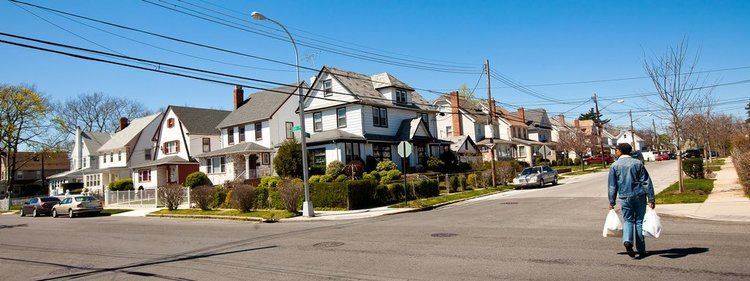ZIP codes 11412, 11423 Hispanic population 13.2% White population 2.3% | State New York Asian population 10.7% Black population 64% Population 20,269 (2010) | |
 | ||
Area codes Area codes 718, 347 and 929, Area code 917 Restaurants Elena's Restaurant 43, Code Lounge NYC, Tastee Jerk, Chef Mom Grill & Bakery, Naz Bakery & Roti Shop | ||
Nyregion hip hop and burgers in hollis queens the new york times
Hollis is a middle-class neighborhood within the southeastern section of the New York City borough of Queens. A predominantly African-American community, the boundaries are considered to be the Atlantic Branch of the Long Island Rail Road to the west, Hillside Avenue to the north, Francis Lewis Boulevard to the east (although parts of Queens Village are addressed as Hollis on water bills), and Murdock Avenue to the south. Much of this area is considered to be within the St. Albans postal district. Hollis is close to Jamaica and Queens Village. The neighborhood is part of Queens Community Board 12. Hollis is patrolled by the NYPD's 113th Precinct. Public schools in the area are operated by the New York City Department of Education.
Contents
- Nyregion hip hop and burgers in hollis queens the new york times
- Map of Hollis Queens NY USA
- History
- Holliswood subsection
- Demographics
- Transportation
- Notable residents
- References
Map of Hollis, Queens, NY, USA
History
The first European settlers were Dutch homesteaders in the 17th century. A century later, early in the American Revolutionary War, it was the site of part of the Battle of Long Island, a battle in which the rebel Brigadier General Nathaniel Woodhull was captured at a tavern on what is now Jamaica Avenue. Woodhull Avenue in Hollis is named after him. The area remained rural until 1885, when developers turned 136 acres (55 ha) into houses, and the area is still developed primarily with single-family houses. In 1898, it became a part of New York City with the rest of the borough of Queens.
Since the end of the Korean War, the neighborhood has been settled primarily by African-American families. In recent years, the area has seen a large influx of South Asians and West Indians. The area has a majority of working parents with many early childhood schools in Hollis. Hollis is mainly within zip codes 11423 and 11412.
Holliswood subsection
Holliswood, previously known as Terrace Heights, is an upper middle class subsection of Hollis bounded by the Hillside Avenue to the south, Francis Lewis Boulevard to the east, Grand Central Parkway to the north, and 188th Street to the west. The neighborhood is part of Queens Community Board 8. At 193rd Street is Foothill Malls, a green traffic median with a memorial marking the main entrance to the upscale subdivision.
A notable local facility was Holliswood Hospital. The hospital provided psychiatric care with 127 beds. On August 16, 2013 the facility was closed.
Demographics
Based on data from the 2010 United States Census, the population of Hollis was 20,269, a decrease of 478 (2.3%) from the 26,061 counted in 2000. Covering an area of 525.10 acres (212.50 ha), the neighborhood had a population density of 38.6 inhabitants per acre (24,700/sq mi; 9,500/km2).
The racial makeup of the neighborhood was 64.0% (12,973) African American, 10.7% (2,167) Asian, 2.3% (460) White, 0.6% (126) Native American, 0.1% (20) Pacific Islander, 4.8% (974) from other races, and 4.3% (876) from two or more races. Hispanic or Latino of any race were 13.2% (2,673) of the population.
Transportation
Long Island Rail Road service is available at the Hollis station, located at 193rd Street and Woodhull Avenue. The station is served mostly by the Hempstead Branch. West of Hollis station is the LIRR's Holban Yard, a freight yard that has been shared with St. Albans for over a century, and has included the Hillside Maintenance Facility since 1991. The Q1, Q2, Q36, Q43, Q76, Q77, Q110 buses serve Hollis, as well as closed-door NICE Bus service at Francis Lewis Boulevard.
The E J Z trains stop nearby at Jamaica Center – Parsons/Archer. The Archer Avenue Lines were supposed to be extended to Hollis as part of a never-completed New York City Subway expansion in 1988.
Notable residents
Since the beginning of hip-hop, the neighborhood has been a hotbed of talent, sparked primarily by the fact that hip-hop producer and icon Russell Simmons is from this community, as is his brother Joseph, who along with his friends Darryl McDaniels and Jason Mizell formed the rap group Run-D.M.C. (who had a hit with the seasonal song "Christmas in Hollis").
Other notable residents include:
Hollis was also home to many notable jazz musicians, especially from the 1930s and 1940s on, according to local resident and jazz historian Phil Schaap.
